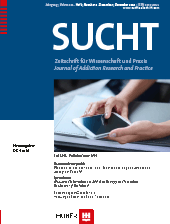Webbasierte Interventionen in der Suchtbehandlung und -prävention: Lösung der Zukunft?
Web-based Interventions in Addiction Therapy and Prevention: The Answer of the Future?
Literatur
(2015). Differenzielle Wirksamkeit einer web-basierten Intervention zur Senkung des Substanzkonsums bei Jugendlichen. SUCHT, 61(6), 377 – 387.
(2013). Approach bias modification in alcohol dependence: Do clinical effects replicate and for whom does it work best? Developmental Cognitive Neuroscience, 4, 38 – 51.
(2015). Persönliche vs. computerbasierte Alkoholintervention für Krankenhauspatienten: Studiendesign. SUCHT, 61(6), 347 – 355.
(2015). Erreichbarkeit Jugendlicher für ein Internet- und SMS-Programm zum Thema Alkohol. SUCHT, 61(6), 357 – 365.
, et al. (2008). Proactive interventions for smoking cessation in general medical practice: a quasi-randomized controlled trial to examine the efficacy of computer-tailored letters and physician-delivered brief advice. Addiction, 103(2), 294 – 304.
(2015). Ergebnisqualität einer web-basierten Tele-Nachsorge nach stationärer medizinischer Rehabilitation Alkoholabhängiger. SUCHT, 61(6), 389 – 398.
(2015). Alcohol use disorder severity and reported reasons not to seek treatment: a cross-sectional study in European primary care practices. Substance Abuse Treatment Prevention and Policy, 10, 10.
, et al. (2009). Konsensuspapier zu Frühinterventionsmaßnahmen bei problematischem Alkoholkonsum in der medizinischen Grundversorgung. SUCHT, 55, 372 – 373.
(2000). Studies on natural recovery from alcohol dependence: Sample slection bias by media solicitation? Addiction, 95, 765 – 775.
(2015). “Click for Support“ – Guidelines for effective web-based interventions for young people in selective drug prevention. SUCHT, 61(6), 367 – 376.
(2014). Changes in the perception of alcohol-related stigma in Germany over the last two decades. Drug and Alcohol Dependence, 143, 225 – 231.
(1998). Introduction to the special section: Ecological momentary assessment in health psychology. Health Psychology, 17(1), 3 – 5.
, et al. (1993). An expert system intervention for smoking cessation. Addictive Behaviors, 18, 269 – 290.
(2011). Retraining Automatic Action Tendencies Changes Alcoholic Patients’ Approach Bias for Alcohol and Improves Treatment Outcome. Psychological Science, 22(4), 490 – 497.



